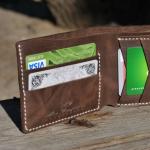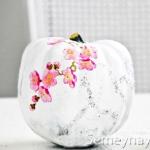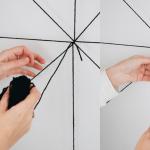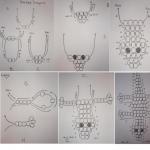Dress pattern 134 size. Pattern of children's a-line dress with vertical reliefs
You will be able to sew many charming models of children's clothes yourself, spending very little time on modeling them. But first, you need a pattern-base dress for a girl to school age which you can build using our instructions. In the future, it can be used when modeling various styles of children's clothing - not only dresses, but also blouses, sweatshirts, bombers, etc. collar to her.
Advice! The basic pattern of the shoulder product, the construction of which is given in the article, can be used to model shoulder products for girls and boys of preschool and primary school age - dresses, blouses, sweatshirts, vests, jackets, etc.
To build a pattern, you need to take the following measurements (in the example, measurements for a height of 122 cm were used):
- Bust 61 cm
- Length to back waist (DTS) 29 cm
- Length to front waist (RTA) 31 cm
- Armhole depth 15 cm
- Back width 26 cm
- Armhole width 7.2 cm
- Front width 26 cm
- Shoulder length 9cm
- Neck circumference 30 cm
- Hips height 12cm
- Back length 60 cm
Building a dress pattern for a girl
From the upper left corner of the sheet, back down 5-6 cm and put point A. From point A, draw down a vertical line along which set aside:
- AG = Depth of armhole to measure + approx. = 15 cm + 1.5 cm = 16.5 cm.
- AT = Length to the waist of the back (DTS) = 29 cm.
- TB = 12cm (Hip Height).
- AH = 60 cm (Product length as measured).
From points A, D, T, B and H, draw horizontal lines of arbitrary length to the right.
Grid width: from point D, draw a horizontal line of arbitrary length to the right and set aside along the horizontal line:
- ГГ1 = ½ Back width by measure (ШС) + approx. = 26/2 + 1.5 = 13 cm + 1.5 cm = 14.5 cm.
- Г1Г2 = Width of the armhole as measured (Шпр) + approx. = 7.2 cm + 2 = 9.2 cm.
- Г2Г3 = ½ Measured breast width (WD) + approx. = 13 cm + 1.5 cm = 14.5 cm.
Draw a vertical segment through point G3; points B, T1, B1, H1 were obtained at the intersection with the horizontal lines.
From point Г1 up, draw a straight line to the intersection with line AB - point P is obtained. From point Г2 draw a perpendicular of arbitrary length.
Side line. Divide the segment Г1Г2 in half - the point Г4 is obtained and from the point Г4 lower the side line down to the line НН1 - the point Н2 is obtained. Designate the point of intersection with the TT1 line with the letter T2, the point of intersection with the waist line BB1 - B2.
Raising the shelf. From point T1 up, set aside the Length to the waist of the front according to the measurement: T1SH = 31 cm. From point W, draw a horizontal segment to the left, at the intersection with the perpendicular from point G2, point P1 is obtained.
Back pattern construction
Neckline. From point A to the right, set aside AA1 = 6 cm (1/6 of the neck circumference by measure plus 1 cm for all sizes): 15/3 + 1 = 6 cm.From point A1 up, set aside A1A2 = 1.5 cm (for all sizes) and connect points A and A2 with a slightly concave line along the pattern.
Back shoulder line. From point P downward, set aside 1.5 cm. From point A2 through point 1.5 (shoulder tilt) draw a line for the shoulder of the back A2P2 = 10 cm (length of the shoulder as measured + 1 cm for landing).
The line of the back of the dress. From point Г1, dividing the angle in half, set aside 2 cm. Draw the armhole line from point P2 through the division point of the segment PG1, point 2 (bisector of the angle) to point Г4.
Building a front pattern
Neckline. From point Ш, cut out the neck of the front using a compass: ШШ1 = R = 1/6 Neck circumference by measure + 1 cm for all sizes): 30 cm / 6 + 1 cm = 6 cm.
Front shoulder line. From point P1, set aside 3 cm downward. Connect point Ш1 and point 3 with a straight line and extend it to the left. Set aside the segment Ш1П3 = 9 cm = Shoulder length according to the measurement along the line.
Armhole line. Draw the bisector of angle G2 and set aside 2 cm along it. Draw the armhole line from point P3 through the midpoint of dividing the segment 3-G2, point 2 (bisector) to point G4.
Modeling flared side seams
To model the flared side seams on the pattern-base of the dress for the girl from the H2 point to the left and right, set aside the required value (the measurement is not constant and may vary depending on the style of the product and the design solution). Draw a line for the bottom of the back of H-H3 and a line for the bottom of the H1-H4 in smooth lines with a slight rise in the side seams.
Pattern-base dress for girls with flared side seams
Separately reshoot the pattern of the back and front on tracing paper and use the basic pattern for further modeling of the products.
Even more interesting and bright ideas, useful tips, and patterns of children's clothing you will find on the website Subscribe to our free lessons and sew children's clothes with us, because it is not only very simple, but also incredibly exciting!
Pattern of a school sundress in life size for girls with a height of 128-134-140 cm.The pattern is printed on a regular printer.
You get immediately three sizes of patterns.
Cut-off dress at the waist, the skirt is folded. Zipper in the middle back seam. Using this pattern, you can sew not only a strict school sundress, but also summer dress for relaxation, picking up bright fabrics.
The pattern is sent instantly to your e-mail (to your e-mail address). The pattern file is located in the attachment letters. You open, print, glue the sheets, cut out the size you need and you can start cutting.
To be able to print the pattern several times, save the file to your computer.
For sewing a school sundress, you will need 0.9 - 1m of fabric (depending on size) with a width of 1.50m. Select fabrics depending on the purpose of the sundress, preferably natural. These can be plain fabrics, color-coded to match your school's dress code. For other cases, fabrics in a cage, striped, etc. are suitable. For the summer version, you can use light fabrics of a wide variety of colors and shades.
The pattern of a school sundress is given in three sizes in full size without seam allowances.
Tables of sizes of children's clothes, as well as the ratio of age, height, chest girth and weight of the child are possible.
Note: Before printing all sheets, print one sheet with a 10x10 cm control square. Make sure that its sides correspond exactly to 10 cm. Achieve this using your printer settings. Now you can print out all the sheets of the pattern and assemble them into one puzzle, according to the scheme, using narrow tape or an adhesive pencil.
The pattern is designed for an age of approximately 7-10 years. Age guidelines are not very reliable, since children at this age are of different heights and different fatness. Therefore, before cutting out the details of the pattern, take the basic measurements from your child: the circumference of the chest and waist, the length to the waist and the entire product, compare with the parameters of the pattern and determine the appropriate size.
Open the school sundress
The patterns are given without seam allowances, therefore, when cutting, do not forget about this and add 1-1.5 cm for the stitching seams, 0.7-0.8 cm is enough for the facing seams, 2-4 cm for the hem of the bottom of the product, depending on the processing method.
When cutting, give additional allowances in those places where refinements are possible after fitting.
Cut details of the school sundress
The bodice of a school sundress for the cool season is recommended to be lined (cut according to the main details).
- Before 1 piece with a fold
- Backrest 2 pieces
- Front panel of the skirt 1 piece with a fold
- Back panel of skirt 2 parts
- Facing the neck and armholes of the front 1 piece (reshoot from the main piece)
- Facing the neck and armholes of the back 2 parts (reshoot from the main piece)
Note: The details of the front and back panels of the skirt are cut according to the same pattern.
Sewing a school sundress
Sweep all open cuts after sewing.
Even a novice dressmaker can easily cope with sewing such a sundress.
Sewing a sundress can be simplified by using a knitted trim to process the neckline.
When sewing a sundress using facing (as provided for in this model), I would suggest the following processing sequence:
- Stitch shoulder sections.
- Reinforce the piping with an adhesive pad, grind off the shoulder edges of the piping.
- Trim the neckline and armholes.
- Stitch side slices bodice.
- Stitch the front and back side sections of the skirt.
- Lay folds on the skirt along the control marks, secure with pins.
- Connect the bodice with the skirt along the waist line.
- Sew the middle cut of the back of the skirt to the reference mark, leaving a section for the zipper.
- Sew in zipper.
- Process the bottom of the product.
The sundress is ready. With a new thing!
Sunday, 01 July 2012 03:57 + in the quote pad
Some kind of solemn event or even just a birthday.
I would like a holiday and guests.
And if this holiday is for a little girl?
I want a double holiday!
I want everything to be perfect and impeccable.
I want to organize an event on a grand scale.
Or even not on a grand scale, but just want to give a child a holiday.
But what to do when prices for fancy dresses are just going through the roof?
I propose to sew a festive festive dress for the girl ourselves.
It will be better than any purchased dresses!
If you know how to sew or if you have a great desire to learn, then you can do it!
Sewing such a dress is very easy and quick.
Dress pattern:
Using this pattern, you can sew more than one festive elegant dress for a girl, but three of these:

However, in order to cut patterns No. 1 and 2, you need to simulate the pattern a little.
Model No. 1
This dress can be combined from two fabrics - check and striped. Flared skirt with a yoke. The bodice has two parts. This dress has a bob cut. A flashlight sleeve with narrow cuffs at the bottom.
Model No. 2
This summer dress for a girl is sewn of fabric with a pattern and trimmed with lace and plain fabric. Small folds-tucks are located in front. The dress will look very good with a belt.
Model No. 3
The highlight of this dress is the wings sewn into the relief line. The dress is fastened in front with buttons. There are folds-tucks on the shelf. The skirt is flared to the bottom, the top of which is assembled. This dress looks very good with a belt.
This dress is designed for size 34, with a height of 134 cm (no seam allowances).
Fabric consumption for a dress: 1 m 55 cm, with a fabric width of 106 cm.
In the choice of style baby dress you need to remember that you can choose the most simple model, but put all the emphasis on the choice of details (braid, lace, fabric, bows, etc.).



Thus, according to this pattern, you can sew a huge number of dresses, and not only smart, but also everyday
Hello. I spread the size range from 80 to 152 cm dress patterns for girls. Loose-cut dress with sleeves.
The pattern is like this.

A dress with a simple cut. Sleeve pattern with a fold, the same line for the front and back.
The neck is high, to which the collar is sewn. If there is no collar, the neck should be deepened and widened.
Despite the fact that the sizes are given up to a height of 152 cm, the patterns are designed for undeveloped children's figures.
The sleeve, of course, need not be sewn on.

Knee-length dress.
Patterns:
| Age / Height / Bust | Pattern |
| 1 year / 80 cm / 50 cm | Download |
| 1.5 years / 86 cm / 52 cm | Download |
| 2 years / 92 cm / 54 cm | Download |
| 3 years / 98 cm / 55 cm | Download |
| 4 years / 104 cm / 57 cm | Download |
| 5 years / 110 cm / 59 cm | Download |
| 6 years / 116 cm / 61 cm | Download |
| 7 years / 122 cm / 63 cm | Download |
| 8 years / 128 cm / 66 cm | Download |
| 9 years / 134 cm / 69 cm | Download |
| 10 years / 140 cm / 72 cm | Download |
| 11 years / 146 cm / 75 cm | Download |
| 12 years / 152 cm / 78 cm | Download |
The second pattern is based on the Müller system. According to German precision, it carries a display of anatomical features. In general, this pattern is for fans of the German pattern building system and not for beginners.
You can use the dart on the back armhole for a good fit, or you can ignore it.

Pattern in PDF file in full size. Set the scale to 100% when printing. After printing, you need to glue the sheets jointly to joint, without overlapping the sheets on top of each other and without cutting off the margins.
The patterns are given without seam allowances.
Patterns:
| Age / Height / Og / About / Length | Pattern |
| 1 year / 80 cm / 54 cm / 57 cm / 38 cm | Download |
| 1.5 years / 86 cm / 55 cm / 58.5 cm / 41 cm | Download |
| 2 years / 92 cm / 56 cm / 60 cm / 44 cm | Download |
| 3 years / 98 cm / 57 cm / 61.5 cm / 47 cm | Download |
| 4 years / 104 cm / 58 cm / 63 cm / 50 cm | Download |
| 5 years / 110 cm / 59 cm / 64.5 cm / 53 cm | Download |
| 6 years / 116 cm / 60 cm / 66 cm / 56 cm | Download |
| 7 years / 122 cm / 62 cm / 68 cm / 60 cm | Download |
| 9 years / 134 cm / 66 cm / 72 cm / 68 cm | Download |
| 10 years / 140 cm / 68 cm / 74 cm / 72 cm | Download |
You can decorate the dress with a collar and lace

shuttlecocks

make the dress layered.

I also collected several options for modeling the pattern: how you can modify the dress.


You can cut off the skirt and make a gather. The width of the skirt is doubled.

Every girl dreams of being at a real ball at least once in her life, just like the heroine of her favorite fairy tale "Cinderella". And not just to be, but also to look like a fairy-tale princess at this ball: in a beautiful, with an intricate hairstyle, elegant shoes, with light makeup... And let your fashionista manage to wear this dress of hers only once - nevertheless, give your child a fairy tale, and your princess will remember such a miraculous transformation for a long time. Our dress pattern for girls will help you transform your beauty not only into a princess. Changing the length of the skirt, the color of the fabric and its texture, it can be easily transformed into an airy snowflake, and into a mysterious flower fairy, and even a Spanish beauty gypsy. Fluffy layered skirts will help create both an airy tutu and an exquisite ballet Chopin. This basic pattern will help you create completely different images.
Show a little more imagination and ruffles, rhinestones, bows. Add elbow-length gloves, a miniature clutch bag, make a tiara.
Patterns changed (July 2016)
You can download a dress pattern for a girl for free at the following links:
| Russian size (height) | Breast coverage | Waist circumference | Hip coverage | Age appropriate | direct link |
| size 86 | 52-54 | 49-51 | 52-54 | 1.5 years | |
| size 92 | 53-55 | 50-52 | 53-56 | 2 years | |
| size 98 | 54-56 | 51-53 | 55-58 | 3 years | |
| size 104 | 55-57 | 52-54 | 57-60 | 4 years | |
| size 110 | 56-58 | 53-55 | 59-62 | 5 years | |
| size 122 | 58-62 | 55-58 | 63-67 | 7 years | |
| size 134 | 64-68 | 58-61 | 69-73 | 9 years |
| Size (height) | Chest girth | Waist circumference | Hip girth | Age appropriate | |
| size 80 | 51-53 | 48-50 | 51-53 | 1 year |
Payment for goods Buy |
| size 116 | 57-59 | 54-56 | 61-64 | 6 years |
Payment for goods Buy |
| size 128 | 61-65 | 57-59 | 66-70 | 8 years |
Payment for goods Buy |
| size 140 | 67-71 | 59-62 | 72-76 | 10 years |
Payment for goods Buy |
| size 146 | 70-74 | 62-64 | 75-80 | 11 years |
Payment for goods Buy |
| size 152 | 74-76 | 64-65 | 79-83 | 12 years old |
Payment for goods Buy |
* As a result of payment, you will be automatically sent a file with a pattern to your specified e-mail. If the file has not arrived, then you need to check whether you entered the correct postal address when paying. If the postal address is correct, but the file has not arrived, you must immediately contact the address [email protected]
Patterns are given without seam allowances.
The set of patterns:
note The skirt consists of several layers. The lower one is a fabric that keeps its shape, the upper ones are soft organza or chiffon.


A variety of dress fabrics at an affordable price can be purchased in the VITEX online store.

Below is a description of sewing an elegant christening dress from one of our readers.

I originally planned to sew Nice dress for her niece, which she could wear for baptism and a couple of other holidays. I liked this model for its simplicity and the ability to choose a pattern for the desired size. My nephew has already grown a little 92, but does not reach 98cm (the girl is 2.5 years old). I decided to sew a little on top and chose a pattern of 98 cm. As it turned out later, I did the right thing, because she got in with difficulty. I printed and cut out the patterns, for sewing I chose white chintz as the main fabric and lace as an additional upper tier of the skirt. I bought 2.5 meters of lace braid, three flower bows and a thin braid with rhinestones, 2 meters. Although the pattern came with sleeves and I even cut them out, I did not sew. I decided that this dress would look nicer without them. I made double patterns for the torso to the waist - so that the chintz did not shine through and to make it look neater. Then I sewed all the details into them, I got patterns to the waist in two copies. I stitched the necklines, head slits and turned the product right side out. After that, I sewed on the front of the armholes, first bending the ends and letting thin laces along the seams so that they were not noticeable. The top of the product was almost complete. I want to note that I cut exactly according to the patterns by 98 cm, I did not make additional allowances for the seams. And then, when the dress was already ready, it sat back to back. Therefore, if you are sewing exactly to your size, then add more allowances for the girl to fit well. You can also enlarge the neckline slightly, sew a zipper in the back, or plant small buttons. In order for the child's head to pass without problems, it is necessary that the two halves of the back are stitched together only at the very bottom and leave a deep cut. On this I got a little stuck and I had to embroider it twice, doing more.
After that, I proceeded to pattern the bottom, only the upper lace layer of the skirt decided to make it more magnificent and therefore I cut it not like the lower one - with the sun, but simply assembled it and stitched it on. I cut the bottom layer exactly according to finished pattern... It turned out to be very elegant and in length - just right. I trimmed the bottom of the upper lace layer with a braid with rhinestones. In order not to catch the eye of the thread, I sharpened with a very thin line. It was transparent and inconspicuous. I trimmed the bottom layer of the dress with lace. Then I connected the top and bottom of the dress from the inside out and processed all the edges on a typewriter. I wanted the bottom of the dress to somehow play - for this I slightly grabbed it into an accordion and raised the ends of the skirt in front on both sides. In the places of capture, I sewed on a white flower and another one on the left on the chest. To make the dress look even more elegant, I bought a very wide transparent mesh ribbon with large flowers embroidered with white lace. I sewed it at the waist to the outside of the dress with hand stitches with transparent thin fishing line. Because of its big size it turned out that the top of the braid was under the bust, and the bottom went over the lace skirt. But it looked good. On the back of the back in a cut, I sewed in a small button and made an air loop out of white threads. But since, as I already wrote, the incision had to be lengthened, at least three buttons were needed there. I finished them later. This was the end of my work with the dress - it turned out to be very airy and beautiful.





